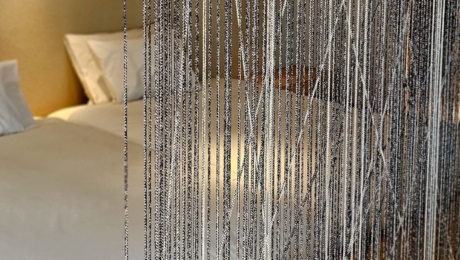

The Infinite Possibilities of Braids
In daily Japanese life, the type of braid most likely to meet the eye is an obijime (sash tightener), used when a woman wraps herself in a traditional Japanese garment. This is a braid in which dyed yarn is interwoven into a pattern. One might unravel 1400 years of history in a single obijime , the earliest examples include the cords used to bind sets of Buddhist sutras held as treasures in the Nara Shosouin, the cords for the Heike Nokyo Sutras preserved by Itsukushima Shrine, scabbard cords for armor and swords of samurai of the Kamakura period (1192-1333). Having journeyed through time and space, the chords remain vibrantly alive to this day.
Ryukobo is the only atelier in Tokyo that carries out the entire process of producing the Japanese clothing accessories obijime and obiage (sash bustle), from the stage of spinning the threads, through dyeing, designed, and braiding. The atelier is supported by the master, Takashi Fukuda, certified as a traditional craftsman by the Tokyo Metropolitan Government, and his son, Ryuta Fukuda. Reliable skills are being passed on, step by step, from father to son.
Ryukobo opened for business in 1963, but it was preceded by over 130 years of making authentic braids. Confidence in their craftsmanship runs deep, appreciated and loved by many luminaries in tea ceremony circles, Kabuki actors, and the Imperial family, who prize quality.
Braided cords are prepared using unique, specialized work stands, called maru-dai (round stands), ayatake-dai (patterned bamboo stands), taka-dai (high stands), and kaku-dai (angular stands). Beautifully dyed silk threads are deftly woven by craftspeople employing dozens of different techniques, but according to a constant rule. High-quality braids have just the right elasticity, making them easy to tie, but difficult to undo. This can only be achieved by a skilled craftsperson, with great concentration, braiding the cords with subtly graded tension. Some braids with complex patterns progress very slowly, at a rate of just a few centimeters per hour.
Recently, Ryukobo, centered on Ryuta as the heir carrying the tradition forward, is aggressively developing new products by evolving braid designs with traditional techniques and know-how. The modern, up-dated braids are collector’s items that can be worn with Western-style clothing as well as traditional Japanese costume. A fashion-oriented approach, sublimating designs to every-day personal wear such as bracelets, is being taken. Umbrellas with “utilitarian beauty” using the braids to good effect are being produced and well-received. Braids offer truly limitless possibilities for freely arranging colors and shapes. Braiding technology, having being inherited from predecessors in many strands, is set to evolve into new shapes.











